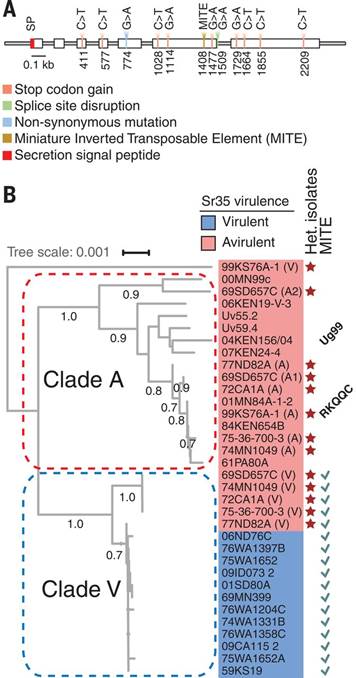《Science》揭秘导致小麦 “超级杀手”小麦秆锈菌毒力变化的基因突变

发表在《Science》杂志上的两项研究阐明了哪些基因突变导致小麦秆锈菌(Pgt)的毒力不断变化。两个研究团队都揭秘了秆锈菌的遗传特征,它们帮助真菌躲过抗病品系。
对于小麦种植者而言,这些研究上的突破也许具有实际的意义。它意味着未来有望在几小时内分析可疑样品,而不是几天,从而避免辛苦种植的作物被毁于一旦。
毒力蛋白一号
在第一项研究中,堪萨斯州立大学领导的研究团队以对秆锈菌敏感和耐受的小麦品系为对象,利用RNA测序和全基因组测序来寻找不同版本的真菌基因。
研究人员首先在显微镜下追踪了感染的早期阶段,发现真菌在此阶段分泌的一种蛋白可能被Sr35小麦抗性蛋白识别。于是,他们利用转录组和全基因组测序来评估和比较天然的Pgt分离株以及经过化学诱变的分离株。
在每个Sr35抗性分离株中,研究人员在Pgt的同一个基因中鉴定出突变。通过一系列的后续实验,他们发现Sr35小麦抗性蛋白通常识别一种称为AvrSr35的真菌分泌蛋白,促使植物产生免疫力。
不过,道高一尺,魔高一丈。秆锈菌似乎绕过了这个过程,它产生了新版本的AvrSr35(插入了移动元件),阻止AvrSr35与Sr35发生相互作用,从而让这个基于Sr35的防御体系失效。
尽管臭名昭著的U99分离株不含AvrSr35突变,但研究小组对烟草属植物的基因表达和免疫共沉淀实验表明,对Ug敏感但含有Sr35基因的小麦携带了Sr35突变,这使得AvrSr35不被发现。
通讯作者、堪萨斯州立大学的植物病理学家Eduard Akhunov表示:“AvrSr35的发现为小麦秆锈菌的监控、宿主易感目标的鉴定以及免疫分子的鉴定提供了一种新工具。”
毒力蛋白二号
在另一项研究中,悉尼大学、澳大利亚联邦科学与工业研究组织(CSIRO)等机构的研究人员发现了秆锈菌的另一个毒力蛋白——AvrSr50,它与小麦抗锈蛋白Sr50发生相互作用。
研究人员测序了一种称为Pgt279的秆锈菌分离株,以及一种能够感染Sr50抗病小麦的Pgt632突变株。通过测序发现的110万个单碱基变异和小的插入缺失,他们将研究范围缩小到一个覆盖20个基因的区域。通过一系列后续实验,他们鉴定出AvrSr50,并证明它能够感染缺乏Sr50抗性蛋白的植物。
真菌的基因组序列数据进一步表明,AvrSr50的毒力版本包含一些序列插入,能够感染表达Sr50的小麦。之后的分析为AvrSr50毒力等位基因的来源和表达模式提供了线索。
悉尼大学的Robert Park和CSIRO的Peter Dodds表示:“AvrSr50的毒力等位基因是通过DNA插入和序列变异而产生的,我们的数据表明,除了性重组之外,体细胞交换也促使新的毒力性状产生。”
堪萨斯州立大学的研究人员也表示:“AvrSr35和AvrSr50的鉴定为真菌病原体的分子监控和早期检测提供了宝贵的工具,未来有望通过抗性基因的采用来阻止疫情发生。”(来源:生物通 薄荷)
Variation in the AvrSr35 gene determines Sr35 resistance against wheat stem rust race Ug99
Abstract Puccinia graminis f. sp. tritici (Pgt) causes wheat stem rust, a devastating fungal disease. The Sr35 resistance gene confers immunity against this pathogen’s most virulent races, including Ug99. We used comparative whole-genome sequencing of chemically mutagenized and natural Pgt isolates to identify a fungal gene named AvrSr35 that is required for Sr35avirulence. The AvrSr35 gene encodes a secreted protein capable of interacting with Sr35 and triggering the immune response. We show that the origin of Pgt isolates virulent on Sr35 is associated with the nonfunctionalization of the AvrSr35 gene by the insertion of a mobile element. The discovery of AvrSr35 provides a new tool for Pgt surveillance, identification of host susceptibility targets, and characterization of the molecular determinants of immunity in wheat.
原文链接:http://science.sciencemag.org/content/sci/358/6370/1604.full.pdf
Loss of AvrSr50 by somatic exchange in stem rust leads to virulence for Sr50 resistance in wheat
Abstract Race-specific resistance genes protect the global wheat crop from stem rust disease caused by Puccinia graminis f. sp. tritici (Pgt) but are often overcome owing to evolution of new virulent races of the pathogen. To understand virulence evolution in Pgt, we identified the protein ligand (AvrSr50) recognized by the Sr50 resistance protein. A spontaneous mutant of Pgt virulent to Sr50 contained a 2.5 mega–base pair loss-of-heterozygosity event. A haustorial secreted protein from this region triggers Sr50-dependent defense responses in planta and interacts directly with the Sr50 protein. Virulence alleles of AvrSr50 have arisen through DNA insertion and sequence divergence, and our data provide molecular evidence that in addition to sexual recombination, somatic exchange can play a role in the emergence of new virulence traits in Pgt.
原文链接:http://science.sciencemag.org/content/sci/358/6370/1607.full.pdf

